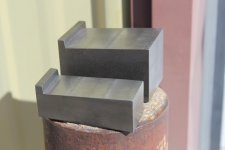jim rozen
Diamond
- Joined
- Feb 26, 2004
- Location
- peekskill, NY
I had lost a small screw from a hardinge indexing toolpost (long story, but it's still somewhere on my basement floor) and took the time to make a new one this weekend.
But the originals are blacked and I felt queasy about putting a bare steel one in place of the original. There's a bit in "Trustee from the Toolroom" about a trick to blue small bits like this.
Damned if it didn't work perfectly.
Basically a small tin dish full of sand, held over the kitchen stove. Buried the screw in the
sand and kept turning it back and forth with some forceps while the tin of sand got hotter and hotter.
Took about three minutes before the part developed a deep blue finish. I had de-greased the part
before doing this, and dropped it oil after it had cooled.
I used to use Brownell's Oxpho cold blue for this. Not any more.
But the originals are blacked and I felt queasy about putting a bare steel one in place of the original. There's a bit in "Trustee from the Toolroom" about a trick to blue small bits like this.
Damned if it didn't work perfectly.
Basically a small tin dish full of sand, held over the kitchen stove. Buried the screw in the
sand and kept turning it back and forth with some forceps while the tin of sand got hotter and hotter.
Took about three minutes before the part developed a deep blue finish. I had de-greased the part
before doing this, and dropped it oil after it had cooled.
I used to use Brownell's Oxpho cold blue for this. Not any more.


 ) but if you use your loaf you'll have no problems.
) but if you use your loaf you'll have no problems.




